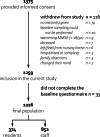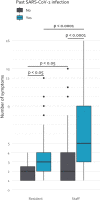The prior infection with SARS-CoV-2 study (PICOV) in nursing home residents and staff - study protocol description and presentation of preliminary findings on symptoms
- PMID: 34763723
- PMCID: PMC8581120
- DOI: 10.1186/s13690-021-00715-z
The prior infection with SARS-CoV-2 study (PICOV) in nursing home residents and staff - study protocol description and presentation of preliminary findings on symptoms
Abstract
Background: The COVID-19 pandemic, caused by the severe acute respiratory syndrome coronavirus 2 (SARS-CoV-2), has presented itself as one of the most important health concerns of the 2020's, and hit the geriatric population the hardest. The presence of co-morbidities and immune ageing in the elderly lead to an increased susceptibility to COVID-19, as is the case for other influenza-like illnesses (ILI) or acute respiratory tract infections (ARI). However, little is known, about the impact of a previous or current infection on the other in terms of susceptibility, immune response, and clinical course. The aim of the "Prior Infection with SARS-COV-2" (PICOV) study is to compare the time to occurrence of an ILI or ARI between participants with a confirmed past SARS-CoV-2 infection (previously infected) and those without a confirmed past infection (naïve) in residents and staff members of nursing homes. This paper describes the study design and population characteristics at baseline.
Methods: In 26 Belgian nursing homes, all eligible residents and staff members were invited to participate, resulting in 1,226 participants. They were classified as naïve or previously infected based on the presence of detectable SARS-CoV-2 antibodies and/or a positive RT-qPCR result before participation in the study. Symptoms from a prior SARS-CoV-2 infection between March and August 2020 were compared between previously infected residents and staff members.
Results: Infection naïve nursing home residents reported fewer symptoms than previously infected residents: on average 1.9 and 3.1 symptoms, respectively (p = 0.016). The same effect was observed for infection naïve staff members and previously infected staff members (3.1 and 6.1 symptoms, respectively; p <0.0001). Moreover, the antibody development after a SARS-CoV-2 infection differs between residents and staff members, as previously infected residents tend to have a higher rate of asymptomatic cases compared to previously infected staff members (20.5% compared to 12.4%; p <0.0001).
Conclusions: We can postulate that COVID-19 disease development and symptomatology are different between a geriatric and younger population. Therefore, the occurrence and severity of a future ILI and/or ARI might vary from resident to staff.
Keywords: ARI; Antibody; Belgium; COVID-19; Cohort; ILI; Multicentric; Nursing home; SARS-CoV-2; Symptoms.
© 2021. The Author(s).
Conflict of interest statement
The authors declare that they have no competing interests.
Figures



Similar articles
-
Seroprevalence of Severe Acute Respiratory Syndrome Coronavirus 2 Among Skilled Nursing Facility Residents and Staff Members-Los Angeles County, August-September 2020.J Infect Dis. 2022 Feb 1;225(3):367-373. doi: 10.1093/infdis/jiab281. J Infect Dis. 2022. PMID: 34031692 Free PMC article.
-
Anti-nucleocapsid antibody levels following initial and repeat SARS-CoV-2 infections in a cohort of long-term care facility residents in England (VIVALDI).Wellcome Open Res. 2024 Feb 19;9:45. doi: 10.12688/wellcomeopenres.20750.1. eCollection 2024. Wellcome Open Res. 2024. PMID: 38818129 Free PMC article.
-
Adverse Events Following One Dose of mRNA COVID-19 Vaccination Among US Nursing Home Residents With and Without a Previous SARS-CoV-2 Infection.J Am Med Dir Assoc. 2021 Nov;22(11):2228-2232. doi: 10.1016/j.jamda.2021.08.024. Epub 2021 Aug 28. J Am Med Dir Assoc. 2021. PMID: 34534492 Free PMC article.
-
Development of morbidity and mortality of SARS-CoV-2 in nursing homes for the elderly in Frankfurt am Main, Germany, 2020-2022: What protective measures are still required?GMS Hyg Infect Control. 2023 Feb 14;18:Doc05. doi: 10.3205/dgkh000431. eCollection 2023. GMS Hyg Infect Control. 2023. PMID: 36875328 Free PMC article.
-
Associations of BNT162b2 vaccination with SARS-CoV-2 infection and hospital admission and death with covid-19 in nursing homes and healthcare workers in Catalonia: prospective cohort study.BMJ. 2021 Aug 18;374:n1868. doi: 10.1136/bmj.n1868. BMJ. 2021. PMID: 34407952 Free PMC article.
Cited by
-
Hybrid Immunity Overcomes Defective Immune Response to COVID-19 Vaccination in Kidney Transplant Recipients.Kidney Int Rep. 2023 Dec 20;9(3):635-648. doi: 10.1016/j.ekir.2023.12.008. eCollection 2024 Mar. Kidney Int Rep. 2023. PMID: 38481503 Free PMC article.
-
Predictors of neutralizing antibody response to BNT162b2 vaccination in allogeneic hematopoietic stem cell transplant recipients.J Hematol Oncol. 2021 Oct 24;14(1):174. doi: 10.1186/s13045-021-01190-3. J Hematol Oncol. 2021. PMID: 34689821 Free PMC article.
-
Functional reprogramming of monocytes in patients with acute and convalescent severe COVID-19.JCI Insight. 2022 Apr 5;7(9):e154183. doi: 10.1172/jci.insight.154183. JCI Insight. 2022. PMID: 35380990 Free PMC article.
-
Systems vaccinology identifies immunological correlates of SARS-CoV-2 vaccine response in solid organ transplant recipients.NPJ Vaccines. 2025 Jul 1;10(1):140. doi: 10.1038/s41541-025-01182-1. NPJ Vaccines. 2025. PMID: 40593765 Free PMC article.
-
Exploratory study of risk factors related to SARS-CoV-2 prevalence in nursing homes in Flanders (Belgium) during the first wave of the COVID-19 pandemic.PLoS One. 2023 Oct 5;18(10):e0292596. doi: 10.1371/journal.pone.0292596. eCollection 2023. PLoS One. 2023. PMID: 37797082 Free PMC article.
References
-
- Zhou P, Yang X-L, Wang X-G, Hu B, Zhang L, Zhang W, Si H-R, Zhu Y, Li B, Huang C-L, Chen H-D, Chen J, Luo Y, Guo H, Jiang R-D, Liu M-Q, Chen Y, Shen X-R, Wang X, Zheng X-S, Zhao K, Chen Q-J, Deng F, Liu L-L, Yan B, Zhan F-X, Wang Y-Y, Xiao G-F, Shi Z-L. A pneumonia outbreak associated with a new coronavirus of probable bat origin. Nature. 2020;579(7798):270–3. doi: 10.1038/s41586-020-2012-7. - DOI - PMC - PubMed
-
- Mori H, Obinata H, Murakami W, Tatsuya K, Sasaki H, Miyake Y, Taniguchi Y, Ota S, Yamaga M, Suyama Y, Tamura K. Comparison of COVID-19 disease between young and elderly patients: Hidden viral shedding of COVID-19. J Infect Chemother. 2021;27(1):70–75. doi: 10.1016/j.jiac.2020.09.003. - DOI - PMC - PubMed
-
- Chen N, Zhou M, Dong X, Qu J, Gong F, Han Y, Qiu Y, Wang J, Liu Y, Wei Y, Xia J, Yu T, Zhang X, Zhang L. Epidemiological and clinical characteristics of 99 cases of 2019 novel coronavirus pneumonia in Wuhan, China: a descriptive study. Lancet. 2020;395(10223):507–13. doi: 10.1016/S0140-6736(20)30211-7. - DOI - PMC - PubMed
LinkOut - more resources
Full Text Sources
Medical
Miscellaneous

